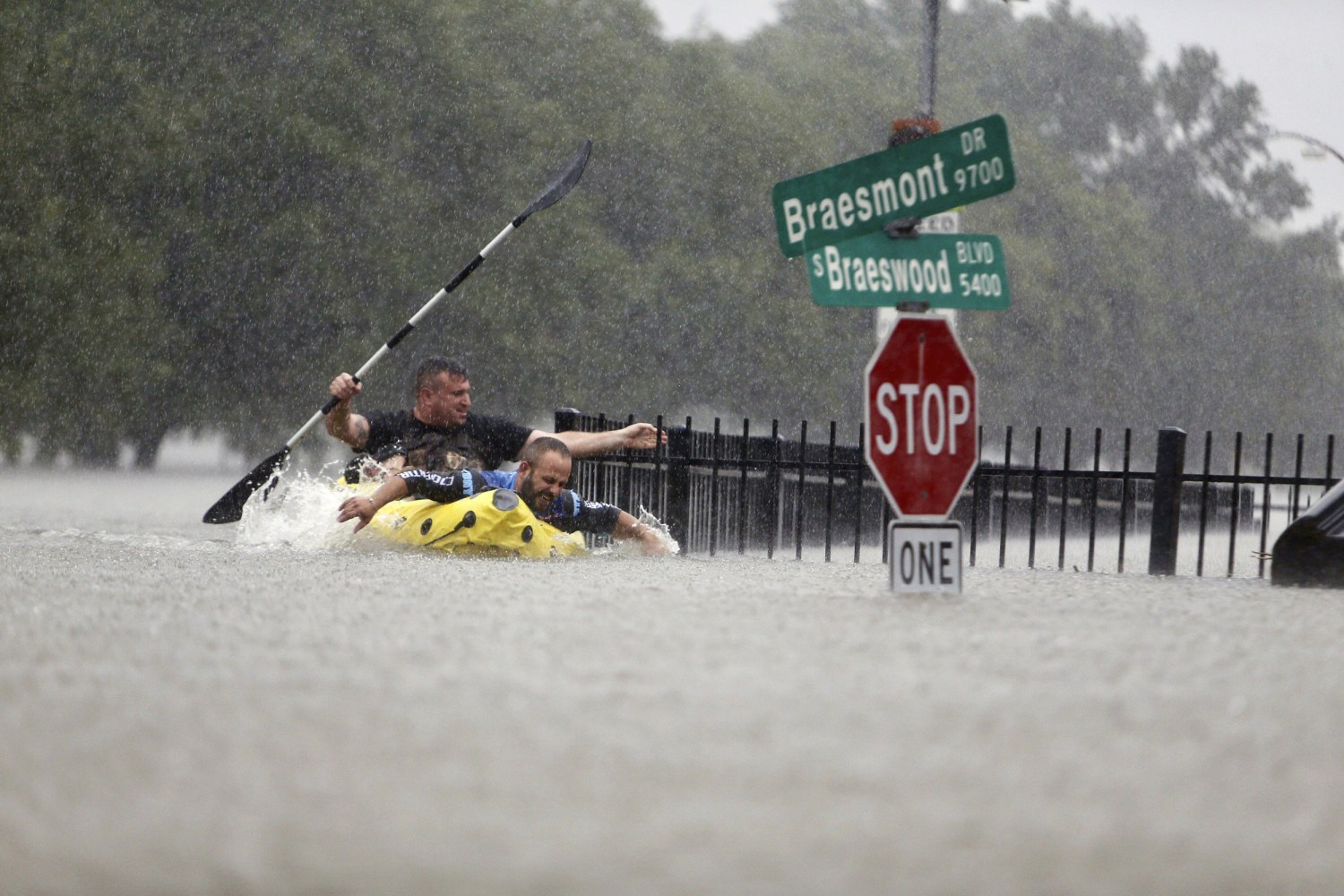Sunday, December 31, 2017
Friday, December 29, 2017
Brains and Eggs' Texan of the Year is ...
Harvey, naturally.
Within a mile from my house -- which stayed high and dry -- people were being rescued from flooded cars on I-610 by raft and by helicopter.
Harvey by the numbers (as of Sept. 1, four months ago):
There are ongoing quarrels about the relief funds raised and how, and if, they are being spent.
Ninety people in the US died as a result of Harvey. Over 185,000 homes were damaged, and more than 364,000 people filed for FEMA relief. A number well in excess of 42,000 went to shelters. Ten thousand were rescued just by federal forces, among them 24,000 National Guardsmen. At least 300,000 lost power for some period of time, and there were some 120,000 people in Beaumont who had to go without clean water for several days, as the public water facility there flooded.
Ten petrochemical refineries in the region were shut down for days, accounting for 3 million daily barrels -- nearly 17% -- of the nation's refining capacity. The most infamous was the Arkema plant in Crosby, near Baytown, which had volatile chemicals that exploded and burned when the plant lost power due to flooding. The facility had no contingency plan for an emergency of this nature due to relaxed enforcement of environmental regulations by Trump's EPA.
My wife and I were not personally affected by Harvey's wrath. We were among the lucky ones. My mother was forced to evacuate, twice, the second time by jet ski, and finally made it to Houston several days after the worst of Harvey moved east to torment others. My childhood home, her home of 57 years, was inundated by 21 inches of water. She lost everything: home, auto, clothing, valuables, keepsakes and mementos. She is now safely ensconced in one of the finest assisted-living facilities in the city, the Village of River Oaks, but not without having endured the physical and emotional stress of so much upheaval and loss. On Christmas Day my wife drove her around to see the Mecom Fountain and Hermann Park and other parts of town between where she is and where we are. She remarked, "I finally feel like a Houstonian."
As for those who were less fortunate, it will be years -- decades perhaps -- for the Texas Gulf Coast, from Rockport to Orange, to recover from this year's 500-year flood event (Houston's third in three years). Then again, Harvey is now being called a 1000-year event.
What about next year's? Or the year after?
I certainly hope I don't have to award any more TOYs to environmental catastrophes.
Within a mile from my house -- which stayed high and dry -- people were being rescued from flooded cars on I-610 by raft and by helicopter.
Harvey by the numbers (as of Sept. 1, four months ago):
More than 20 trillion gallons: That's the total amount of rain that fell across Texas and Louisiana, a staggering deluge that represents enough water to supply New York City's needs for over five decades.
51.88 inches: The amount of rain recorded at Cedar Bayou on the outskirts of Houston in just under five days, marking a new record for the heaviest rainfall for a storm in the continental U.S., according to the National Weather Service.
$125 billion: (Texas Gov.) Greg Abbott said his state will need federal relief money "far in excess" of that total. Moody’s Analytics has estimated $97 billion in destruction alone and some $108 billion in total damages, counting lost output. More recent estimates put the tally close to $200 billion.
There are ongoing quarrels about the relief funds raised and how, and if, they are being spent.
Ninety people in the US died as a result of Harvey. Over 185,000 homes were damaged, and more than 364,000 people filed for FEMA relief. A number well in excess of 42,000 went to shelters. Ten thousand were rescued just by federal forces, among them 24,000 National Guardsmen. At least 300,000 lost power for some period of time, and there were some 120,000 people in Beaumont who had to go without clean water for several days, as the public water facility there flooded.
Ten petrochemical refineries in the region were shut down for days, accounting for 3 million daily barrels -- nearly 17% -- of the nation's refining capacity. The most infamous was the Arkema plant in Crosby, near Baytown, which had volatile chemicals that exploded and burned when the plant lost power due to flooding. The facility had no contingency plan for an emergency of this nature due to relaxed enforcement of environmental regulations by Trump's EPA.
My wife and I were not personally affected by Harvey's wrath. We were among the lucky ones. My mother was forced to evacuate, twice, the second time by jet ski, and finally made it to Houston several days after the worst of Harvey moved east to torment others. My childhood home, her home of 57 years, was inundated by 21 inches of water. She lost everything: home, auto, clothing, valuables, keepsakes and mementos. She is now safely ensconced in one of the finest assisted-living facilities in the city, the Village of River Oaks, but not without having endured the physical and emotional stress of so much upheaval and loss. On Christmas Day my wife drove her around to see the Mecom Fountain and Hermann Park and other parts of town between where she is and where we are. She remarked, "I finally feel like a Houstonian."
As for those who were less fortunate, it will be years -- decades perhaps -- for the Texas Gulf Coast, from Rockport to Orange, to recover from this year's 500-year flood event (Houston's third in three years). Then again, Harvey is now being called a 1000-year event.
What about next year's? Or the year after?
I certainly hope I don't have to award any more TOYs to environmental catastrophes.
Subscribe to:
Posts (Atom)



/cdn.vox-cdn.com/uploads/chorus_image/image/56376201/839306812.0.jpg)
